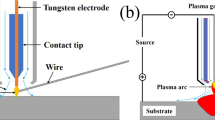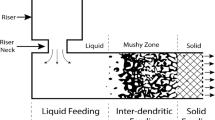Abstract
This research aims to evaluate horizontal and vertical constrained rod casting (CRC) molds on hot tearing susceptibility (HTS) of Al-xCu casting alloys with 2.2, 3.6, 7.5, and 12.5 percent Cu. The hot tears on the casting product were observed using a macroscopic approach. In addition, the hot tearing susceptibility of each casting product prepared using these molds was evaluated using the HTS formula. The results show that the vertical CRC mold has a higher HTS value than the horizontal CRC mold. The rod length is a significant factor in causing hot tearing. Longer rods are more susceptible to hot tearing. The horizontal CRC mold provides a clearer effect of rod length and Cu composition on the average HTS value. In the vertical CRC mold, the effect of Cu composition on the average HTS value is less clear. Therefore, it is highly recommended to use horizontal CRC mold for HTS testing of aluminum casting alloys.












Similar content being viewed by others
References
Y. Li, H. Li, L. Katgerman, Q. Du, J. Zhang, L. Zhuang, Recent advances in hot tearing during casting of aluminum alloys. Prog. Mater. Sci. 117, 100741 (2021). https://doi.org/10.1016/j.pmatsci.2020.100741
S. Li, D. Apelian, Hot tearing of aluminum alloys. Int. J. Met. 5, 23–40 (2011). https://doi.org/10.1007/BF03355505
Suyitno, W.H. Kool, L. Katgerman, Integrated approach for prediction of hot tearing. Metall. Mater. Trans. A 40, 2388–2400 (2009). https://doi.org/10.1007/s11661-009-9941-y
D.G. Eskin, Suyitno, L. Katgerman, Mechanical properties in the semi-solid state and hot tearing of aluminum alloys. Prog. Mater. Sci. 49, 629–711 (2004). https://doi.org/10.1016/S0079-6425(03)00037-9
G. Cao, S. Kou, Hot tearing of ternary Mg−Al−Ca alloy castings. Metall. Mater. Trans. A 37, 3647–3663 (2006). https://doi.org/10.1007/s11661-006-1059-x
S. Kou, A criterion for cracking during solidification. Acta Mater. 88, 366–374 (2015). https://doi.org/10.1016/j.actamat.2015.01.034
A. Hamadellah, A. Bouayad, C. Gerometta, Hot tear characterization of AlCu5MgTi and AlSi9 casting alloys using an instrumented constrained six rods casting method. J. Mater. Process. Technol. 244, 282–288 (2017). https://doi.org/10.1016/j.jmatprotec.2017.01.030
M.O. Pekguleryuz, X. Li, C.A. Aliravci, In-Situ Investigation of hot tearing in aluminum alloy AA1050 via acoustic emission and cooling curve analysis. Metall. Mater. Trans. A 40, 1436–1456 (2009). https://doi.org/10.1007/s11661-009-9806-4
G. Cao, I. Haygood, S. Kou, Onset of hot tearing in ternary Mg-Al-Sr alloy castings. Metall. Mater. Trans. A 41, 2139–2150 (2010). https://doi.org/10.1007/s11661-010-0248-9
S.N. Dubey, Design and evaluation of an enhanced constrained rod casting mold for experimental characterization of hot tearing in aluminum casting alloys. Int. J. Cast Met. Res. 30, 201–216 (2017). https://doi.org/10.1080/13640461.2017.1286553
Z. Wang, Y. Huang, A. Srinivasan, Z. Liu, F. Beckmann, K.U. Kainer, N. Hort, Hot tearing susceptibility of binary Mg–Y alloy castings. Mater. Des. 47, 90–100 (2013). https://doi.org/10.1016/j.matdes.2012.12.044
G. Cao, S. Kou, Hot cracking of binary Mg-Al alloy castings. Mater. Sci. Eng. A 417, 230–238 (2006). https://doi.org/10.1016/j.msea.2005.10.050
S. Lin, C. Aliravci, M.O. Pekguleryuz, Hot-tear susceptibility of aluminum wrought alloys and the effect of grain refining. Metall. Mater. Trans. A 38, 1056–1068 (2007). https://doi.org/10.1007/s11661-007-9132-7
H. Kamguo Kamga, D. Larouche, M. Bournane, A. Rahem, Solidification of aluminum-copper B206 alloys with iron and silicon additions. Metall. Mater. Trans. A 41, 2844–2855 (2010). https://doi.org/10.1007/s11661-010-0293-4
B. Hu, Z. Li, D. Li, T. Ying, X. Zeng, W. Ding, A hot tearing criterion based on solidification microstructure in cast alloys. J. Mater. Sci. Technol. 105, 68–80 (2022). https://doi.org/10.1016/j.jmst.2021.06.071
H. Huang, P.H. Fu, Y.X. Wang, L.M. Peng, H.Y. Jiang, Effect of pouring and mold temperatures on hot tearing susceptibility of AZ91D and Mg-3Nd-0.2Zn-Zr Mg alloys. Trans. Nonferrous Met. Soc. China 24, 922–929 (2014). https://doi.org/10.1016/S1003-6326(14)63144-7
V. Malau, H. Akhyar, P.T. Iswanto, Modification of constrained rod casting mold for new hot tearing measurement. Arch. Metall. Mater. 63, 1201–1208 (2018). https://doi.org/10.24425/123792
H. Akhyar, V. Malau, Suyitno, P.T. Iswanto, Hot tearing susceptibility of aluminum alloys using CRCM-horizontal mold. Results Phys. 7, 1030–1039 (2017). https://doi.org/10.1016/j.rinp.2017.02.041
M. Uludağ, R. Çetin, D. Dispinar, M. Tiryakioğlu, The effects of degassing, grain refinement & Sr-addition on melt quality-hot tear sensitivity relationships in cast A380 aluminum alloy. Eng. Fail. Anal. 90, 90–102 (2018). https://doi.org/10.1016/j.engfailanal.2018.03.025
D. Cheng, L. Zhang, G. Wu, J. Mao, W. Liu, Effects of Cu content on the microstructure, mechanical property, and hot tearing susceptibility of die casting hypereutectic Al–22Si–0.4Mg alloy. J. Mater. Res. 31, 3629–3637 (2016). https://doi.org/10.1557/jmr.2016.388
G. Zou, H. Zhang, Y. Yang, F. Lu, Z. Yu, C. Wang, Effects of pouring and mold temperatures on the fluidity and hot tearing susceptibility of Al–3.5Si–0.5Mg–0.4Cu Alloy. Trans. Indian Inst. Met. 73, 2511–2517 (2020). https://doi.org/10.1007/s12666-020-02058-9
A.M. Nabawy, A.M. Samuel, H.W. Doty, F.H. Samuel, A review on the criteria of hot tearing susceptibility of aluminum cast alloys. Int. J. Met. 15, 1362–1374 (2021). https://doi.org/10.1007/s40962-020-00559-3
I.I. Novikov, O.E. Grushko, Hot cracking susceptibility of Al–Cu–Li and Al–Cu–Li–Mn alloys. Mater. Sci. Technol. 11, 926–932 (1995). https://doi.org/10.1179/mst.1995.11.9.926
J. Campbell, Complete casting handbook: metal casting processes, metallurgy, techniques and design, 1st edn. (Elsevier, Amsterdam, 2011), pp.137–139
Y. Guo, L. Zhang, G. Wu, Y. Wang, F. Qi, X. Xu, X. Tong, Influence of Cu addition on hot tearing susceptibility and fluidity of Al-Li-Cu alloys: Experimental investigation, criterion prediction and simulation assessment. J. Alloys Compd. 969, 172301 (2023). https://doi.org/10.1016/j.jallcom.2023.172301
S. Li, K. Sadayappan, D. Apelian, Characterisation of hot tearing in Al cast alloys: Methodology and procedures. Int. J. Cast Met. Res. 24, 88–95 (2011). https://doi.org/10.1179/1743133610Y.0000000004
J. Campbell, Complete casting handbook: metal casting processes, metallurgy, techniques and design, 2nd edn. (Butterworth-Heinemann, Oxford, 2015), pp.417–445
M.H. Ghoncheh, S.G. Shabestari, A. Asgari, M. Karimzadeh, Nonmechanical criteria proposed for prediction of hot tearing sensitivity in 2024 aluminum alloy. Trans. Nonferrous Met. Soc. China 28, 848–857 (2018). https://doi.org/10.1016/S1003-6326(18)64718-1
Suyitno, V.I. Savran, D.G. Eskin. L. Katgerman, Effects of alloy composition and casting speed on structure formation and hot tearing during direct-chill casting of Al-Cu alloys. Metall. Mater. Trans. A Phys. Metall. Mater. Sci. 35A, 3551–3561 (2004). https://doi.org/10.1007/s11661-004-0192-7
Suyitno, D.G. Eskin, L. Katgerman, Structure observations related to hot tearing of Al–Cu billets produced by direct-chill casting. Mater. Sci. Eng. A 420, 1–7 (2006). https://doi.org/10.1016/j.msea.2005.12.037
E. Pujiyulianto, Suyitno, K. Rajagukguk, B. Arifvianto, L. Katgerman, F. Paundra, H.T. Yudistira, F.P. Nurullah, A. Muhyi, M.F. Arif, Effect of chemical composition on hot cracking susceptibility (HCS) using various hot cracking criteria. Eng. Fail. Anal. 152, 107501 (2023). https://doi.org/10.1016/j.engfailanal.2023.107501
S.R. Sama, T. Badamo, P. Lynch, G. Manogharan, Novel sprue designs in metal casting via 3D sand-printing. Addit. Manuf. 25, 563–578 (2019). https://doi.org/10.1016/j.addma.2018.12.009
S.H. Majidi, C. Beckermann, Modelling of air entrainment during pouring of metal castings. Int. J. Cast Met. Res. 30, 301–315 (2017). https://doi.org/10.1080/13640461.2017.1307624
G. Razaz, T. Carlberg, Hot tearing susceptibility of AA3000 aluminum alloy containing Cu, Ti, and Zr. Metall. Mater. Trans. A 50, 3842–3854 (2019). https://doi.org/10.1007/s11661-019-05290-1
Acknowledgment
This work is supported by PT. Ontiyus Karya Mulia, Indonesia. The authors are grateful to Bambang Tiroso for the support in sending the vertical CRC mold.
Funding
This work was financially by The Ministry of Education and Culture, Republic of Indonesia with a research grant No. 1661/UN1/DITLIT/Dit-Lit/PT.01.03/2022, Universitas Gadjah Mada and Institut Teknologi Sumatera, Indonesia
Author information
Authors and Affiliations
Corresponding author
Ethics declarations
Conflict of interests
The authors declare that they have no known competing financial interests or personal relationships that could have appeared to influence the work reported in this paper.
Additional information
Publisher's Note
Springer Nature remains neutral with regard to jurisdictional claims in published maps and institutional affiliations.
Rights and permissions
Springer Nature or its licensor (e.g. a society or other partner) holds exclusive rights to this article under a publishing agreement with the author(s) or other rightsholder(s); author self-archiving of the accepted manuscript version of this article is solely governed by the terms of such publishing agreement and applicable law.
About this article
Cite this article
Rajagukguk, K., Suyitno, S., Saptoadi, H. et al. Evaluation of Horizontal and Vertical Constrained Rod Casting Mold on Hot Tearing Susceptibility of Al-Cu Alloys. Inter Metalcast (2024). https://doi.org/10.1007/s40962-023-01250-z
Received:
Accepted:
Published:
DOI: https://doi.org/10.1007/s40962-023-01250-z




